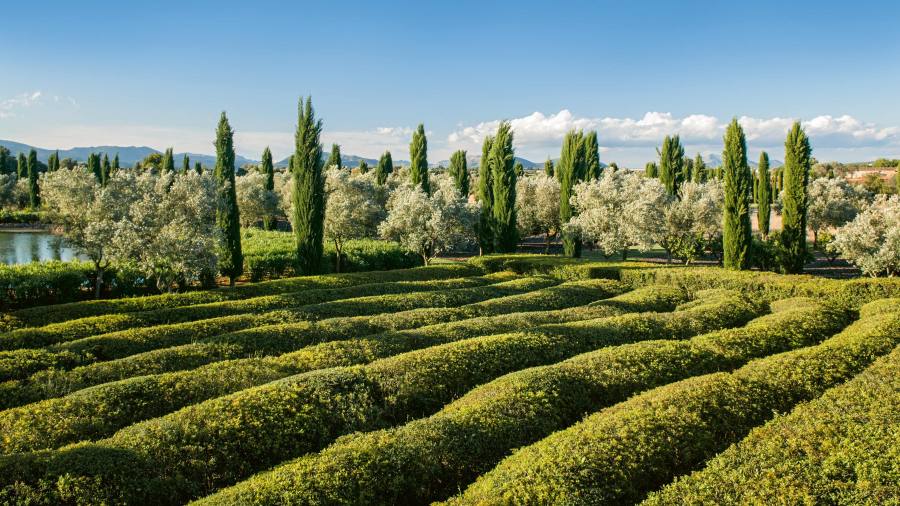The Spaniard Fernando Caruncho is acclaimed for his vast minimalist landscapes but much prefers to be called a gardener, one who believes that his profession goes beyond planting and beautifying: it is “a way of being a being. human “. Inspired by their role in ancient civilizations, he sees gardens as essential for us to feel at one with nature – to feel whole. It is therefore not surprising to learn that he began his adult life studying philosophy at the University of Madrid, where he explored the fundamental role that gardens played in the lives of ancient Greek philosophers. Plato taught his students in the garden of Akademos while Aristotle’s high school was a green land with a shady grove (from which it takes its name) and a botanical garden. These were the places where the physical and the spiritual came together. “The garden is the place of knowledge. It’s a fundamentally spiritual point of view, ”he says.

Raked gravel at Estudio Caruncho, on the outskirts of Madrid, Spain © Maru Serrano
Upon graduating from college, Caruncho turned to garden design and got his first break at age 20 when an uncle – the owner of a Modernist house imagined by Richard Neutra – asked him to work on the garden. It was inspired by Japan and Prince Toshihito’s garden in Katsura (“The proportions matched exactly those in my uncle’s garden”), a masterclass on the power of geometry and the perfect balance in the superposition of rocks and water (“Geometry is a sacred code,” he adds, reflecting on the lessons he learned from the imperial villa). His own rather austere and reductive garden design caused a stir and, after being featured in Vogue magazine, his career took off.
More than 40 years later, Caruncho’s work is the subject of a Rizzoli book entitled Reflections of paradise: Fernando Caruncho’s gardens. It traces the early successes of Mas de les Voltes, an agricultural estate in Spain where large wheat fields were an essential part of the overall project, used almost like golden beds capturing natural light, alongside long rows of cypress trees. and olive trees. In New Zealand, he created a garden with vast waves of curving sea-inspired shrubs, reflected in the plot’s crescent-shaped pool, a reflection on the moon. The same physical expression of poetics can be seen in Puglia, Italy, where on a bare hill he planted a vineyard – the vines arranged like the lines of a musical score that seem to be in constant motion. They possess, he says, “that hint of mystery and sublimation which, like all beauty, hurts from a distance”. His garden in the Peloponnese is also important, and here he built the undulating stone walls of a crumbling hillside building (“For three years we have built, wall after wall, a colossal task” , he says), which are planted with cypress and mastic. The design reveals his love of rocks and waterfalls and the play of light on the water.
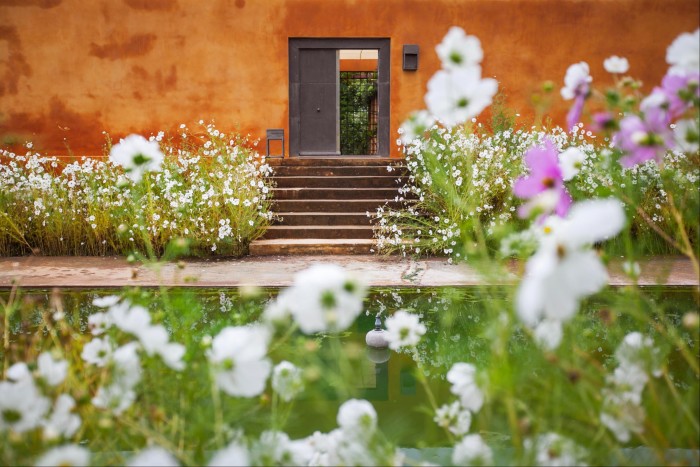
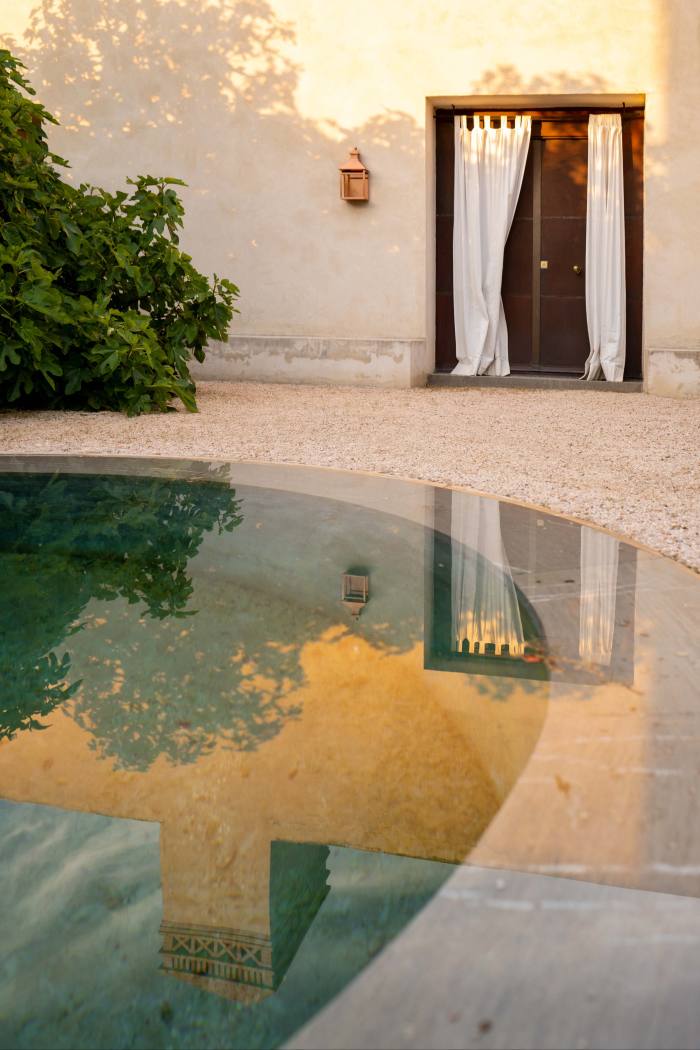
A fountain in the courtyard of the Estudio Caruncho © Maru Serrano
But the gardens of Caruncho are not always colossal. He reminds us that Spanish patios and courtyards are often places of great beauty, some sporting fountains, others filled with jasmine or lemon or orange trees in bloom. “The Far East is also full of incredible examples of how a small space can become a whole world. Five small boulders, raked gravel, moss growing on the rocks … this exquisite detail on the back wall surrounding a patio in Japan becomes almost a prayer connecting man to nature, ”he explains. “It’s not a question of size. It’s the light that counts. While nature helps you more in large gardens, it is more difficult to solve the riddle of the small garden.
It’s a challenge that Caruncho likes to take up. Just look at Madrid, where he lives and works, and the garden he created in what was once a garage. “We installed a skylight, which gives the space a light from another world, it’s almost religious, as if it were a church,” he says of the project. He is currently working on two small plots in Manhattan, one of just 700m², “where we install incredible mosaics”, and the other an even smaller 400m² terrace “where the sky will be bigger than ever”.

A linear swimming pool and palm trees in a garden in Sotogrande, Spain © Raúl Tomás

Whatever its size, Caruncho’s design approach is to capture the inner poetic sense of a place. “For me, designing gardens is an ancestral rite that man repeats over and over again,” he explains to landscape architect Gordon Taylor in the book’s introduction. “It’s an intimate and secret desire to make sense of one’s own life. By transforming the “place”, he seeks to understand that it is part of the cosmos and not alone in front of the history or the mystery of creation. Caruncho deeply believes in the restorative and redemptive power of nature. “A garden is the place where man finds his whole being”, he says.
Caruncho’s goal is to create a transformative space. He often uses a minimal palette, referring to the natural colors of the surrounding landscape. Critics have accused him of not liking flowers, which are used sparingly, but he insists he loves them. “There is nothing more delicate, wonderful, surprising and beautiful than a jasmine, a rose, an orange blossom or a camellia,” he says, revealing that he plants flowers with restraint to emphasize or enhance an overall scheme. He is known to use the massive plantings of a single plant – cosmos or camellias, oleanders, figs, cypress or olive trees – in their praise. “A flower is all flowers,” he says. ” In Mediterranean [where most of his gardens can be found] the flowering period is very short, mainly from May to June, which is why I use the flower as a counterpoint between the trees and the rocks.
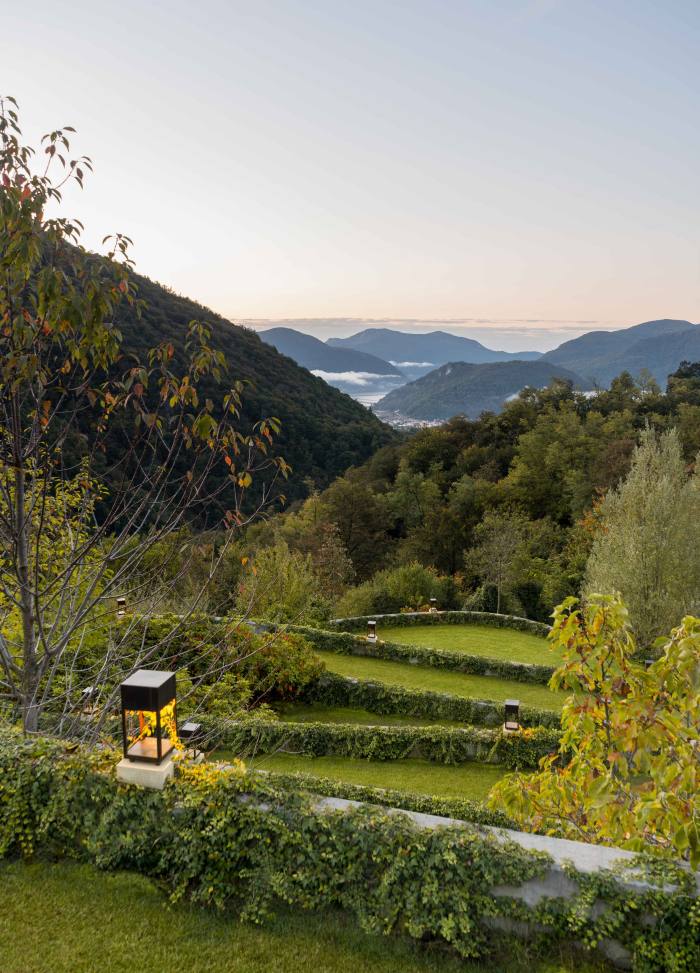
The “dragon” terraced garden of the House and Garden of the Seven Mountains, Lugano, Switzerland © Maru Serrano
Caruncho also uses empty space, a necessity for what he calls “emptiness” against “fullness”, believing it as essential in a landscape as silence is in music. He talks about his project in New Zealand where an elliptical meadow sits between a pavilion housing a spa and its crescent-shaped lunar pool, which functions as a receptacle of light.
Not everyone, he admits, understands or likes his way of working, “that’s why I turn down a lot of projects,” he says, explaining that he sees the creation of a garden as an art form. Each space is a living work of art that dies and is reborn, and each is individual, requiring a response that summons the spirit of the place. It is the living and changing environment that makes each project so unique. The three elements he considers critical are geometry, water and light, and his starting point, even when designing a small urban garden, is the sky.
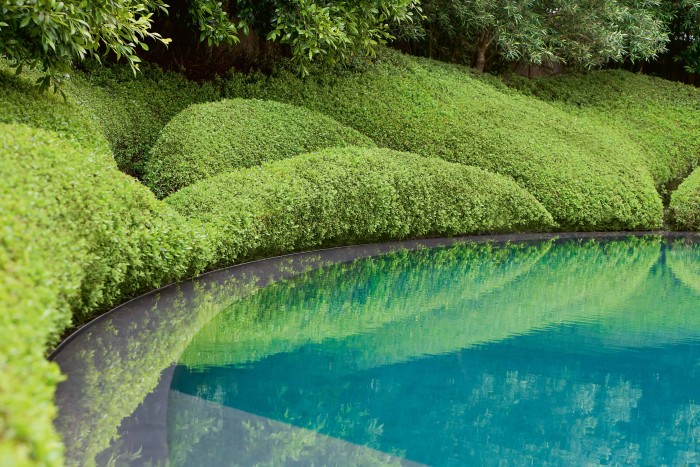

A circular swimming pool at the Flynn de Caruncho project, near Boca Raton, Florida © Raúl Tomás
Oddly enough, Caruncho only ever designed one English garden, owned by Iranian fund manager Kaveh and jewelry designer Cora Sheibani. “It is a very cultivated family who had bought an 18th century presbytery where the garden was completely overgrown with vegetation but with a magical hectare of two and a half hectares”, remembers Caruncho. “The first thing we did was create an empty space between the beds and the house, and we designed three huge flowerbeds while opening up the view. For Sheibani, who studied an extensive collection of gardening books when purchasing the home, the Caruncho aesthetic stood out. “I wanted someone with a 70 year vision because you are not just building for yourself, but for the next generation. Caruncho had that, ”she says. “He’s also a landscaper, unlike Gertrude Jekyll gardening, which requires an army of gardeners to maintain him. I was drawn to minimalist sculpture and wanted a structure to make it look beautiful the whole time. Thus, instead of a traditional herbaceous border, there is a rather zen greenery with predominance of boxwood and lavender.The beds are planted with a narrow-edged lawn filled with lavender in spring and cosmos in summer. Although the Sheibanis have since sold the house, they like to think of the garden they left behind as timeless – a place to reconnect with nature.
Reflections of Paradise: The Gardens of Fernando Caruncho is released by Rizzoli at $ 85

